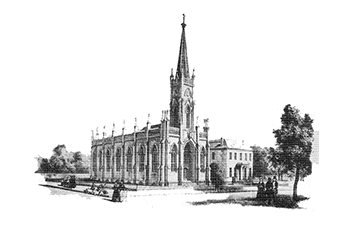St. Mary’s Cathedral Narrowly Escapes Descruction by Fire
SUBMITTED BY MICHAEL MURPHY
Narrowly Escapes Destruction by Fire – Heroic Work of Some of Our Young Men–Damage About $200.
St. Mary's Cathedral, one of the largest, handsomest and most imposing church edifices in the city of Natchez, had a very narrow escape from destruction by fire yesterday morning, between twelve and one o'clock, and had it not been for the timely discovery of the flames by Police Officer Stevens that beautiful structure might now be lying in ruins. Officer Stevens, who was on night duty, tells us that having heard a noise in Locust alley, in the vicinity of which one or two burglaries have lately occurred, he went through that thoroughfare to Main Street, and while standing at the corner at about a quarter past twelve o'clock, midnight, he noticed an unusual light in St. Mary's Cathedral. He watched it for several minutes, but as it did not burn steadily like candles or a lamp, and kept getting brighter and brighter, he concluded that something must be wrong; that the interior of the church must be on fire.
The Club Saloon of Mr. B. Salvo was still open, and Officer Stevens went over there and told Mr. Salvo and several young gentlemen who were eating supper that he believed the Cathedral was on fire. They at once went with him, and finding the doors of the church locked, proceeded to the Episcopal residence, where they secured the key of the Sacristy door. Upon entering they found the sacred edifice filled with smoke and the flames slowly lapping up the wood work on the left of the altar as you enter the church. Finding prompt action necessary, they immediately began using overcoats and other cloths to smother the flames, while others of the party went for water. In a few moments the fire was subdued, and without an alarm, but not until about $150 to $200 damage had been done, and Officer Stevens had been painfully burned on the right hand by the wax from the candle that had caused the blaze. The origin of the fire seems to have been in the following manner: Mass was said in the church on Thursday evening, and after benediction all the lights on the altar were thought to have been extinguished. But it appears that one of the larger candles on the left of the altar, which was thought to be unlighted during the services, was really burning down the centre, the wax not melting and being consumed as the wick grew shorter. This candle, which is three or four inches in diameter, continued to burn down its interior until the hot wax caught fire and ignited the wood work surrounding the altar. The flames burned through the wood work to the tabernacle, but this being of iron stayed course for the time, but not until considerable damage had been done.
Had not the fire been discovered as timely as it was by Officer Stevens, and had not there been such prompt action on his part and of the other gentlemen who went to his assistance, the church would certainly have been destroyed. Both he and the other gentlemen are entitled to credit for their heroic work, and Very Rev. Th. Meerschaert, Administrator of the Diocese, in a card elsewhere, thanks them for their labors. Its destruction would indeed have been a great blow both to the Catholic congregation and the city of Natchez, of which the Cathedral is an ornament. The church has but recently been repaired and decorated in its interior by artists and fresco painters, and the loss, if totally destroyed, would have been very great. As it was, however, the damage was confined to the altar, and the smoke did no harm to the beautiful paintings and fresco work.
Taken from The Weekly Democrat, June 5, 1889.
Submitted by Mike Murphy for St. Mary Basilica Archives.

